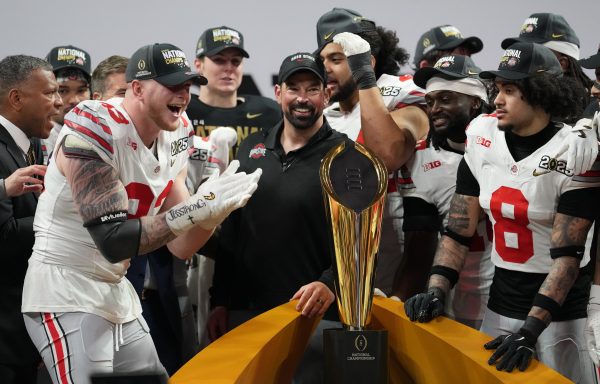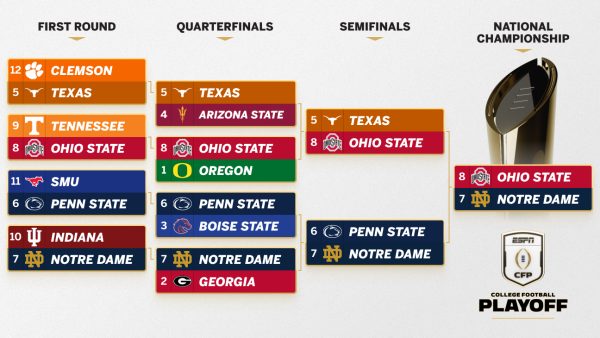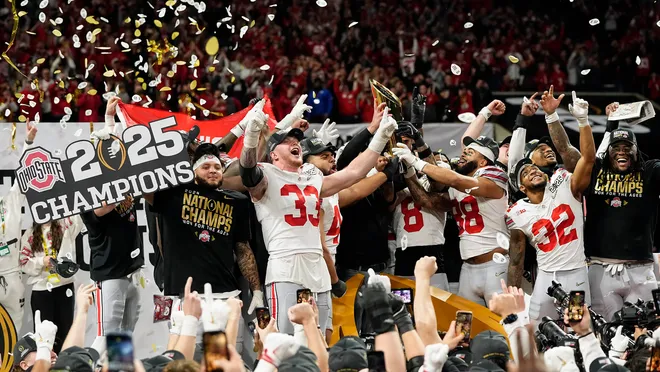Seven weeks ago, when Ohio State lost 13-10 to Michigan, many questioned whether head coach Ryan Day would keep his job the following season. A national championship victory seemed out of the picture. Day may have finally silenced his doubters after guiding the Buckeyes to their first national championship in a decade with a 34-24 victory over Notre Dame. “It’s a great story about a bunch of guys who have just overcome some tough situations, and at the point where there’s a lot of people that counted us out (they) just kept swinging and kept fighting,” Day said, “It’s the reason you get into coaching, to see guys overcome things, learn life lessons and then reach  their dreams. This is what happened tonight.” Notre Dame took a 7-0 lead early on an 18-play touchdown drive. Still, Ohio State’s offense, led by quarterback Will Howard, took control from there, scoring touchdowns on their first four drives, marking the first time this has been done in national championship history. The Buckeyes were leading 31-7 midway through the 3rd quarter, but the Fighting Irish managed to cut this deficit to eight points by scoring two touchdowns and two 2-point conversions. Ohio State fended off Notre Dame’s late rally by converting on 3rd and 11 with a 56-yard gain on a pass from Howard to receiver Jeremiah Smith. The Buckeyes then made a 33-yard field goal to put them up by 11 with 26 seconds remaining to seal their victory. Will Howard was named the Offensive MVP after throwing for 231 yards, rushing for 57 yards, and scoring two touchdowns with an 81% completion rate. Senior linebacker Cody Simon earned the Defensive MVP by anchoring the defense, recording eight tackles in the win. The NFL draft stock of both players may continue to soar following this victory.
their dreams. This is what happened tonight.” Notre Dame took a 7-0 lead early on an 18-play touchdown drive. Still, Ohio State’s offense, led by quarterback Will Howard, took control from there, scoring touchdowns on their first four drives, marking the first time this has been done in national championship history. The Buckeyes were leading 31-7 midway through the 3rd quarter, but the Fighting Irish managed to cut this deficit to eight points by scoring two touchdowns and two 2-point conversions. Ohio State fended off Notre Dame’s late rally by converting on 3rd and 11 with a 56-yard gain on a pass from Howard to receiver Jeremiah Smith. The Buckeyes then made a 33-yard field goal to put them up by 11 with 26 seconds remaining to seal their victory. Will Howard was named the Offensive MVP after throwing for 231 yards, rushing for 57 yards, and scoring two touchdowns with an 81% completion rate. Senior linebacker Cody Simon earned the Defensive MVP by anchoring the defense, recording eight tackles in the win. The NFL draft stock of both players may continue to soar following this victory.
This matchup marks the first-ever national championship played within the new 12-team playoff format. The National Collegiate Athletic Association (NCAA) has held an annual College Football Playoff (CFP) to determine the national champion at the Division 1 FBS level since 2014, initially using a four-team format that remained in place until this season. However, in 2023, the CFP board of managers voted to expand the playoff to twelve teams by 2024, a format that will last through at least the end of the 2025 season. The new tournament featured a round of playoffs separate from bowl games for the first time. A team’s top 25 ranking in this tournament won’t always correlate to their playoff seed. The four highest-ranked conference champions receive the top four seeds regardless of their rank in the top 25. For example, Ohio State’s top 25 ranking was six, but they were seeded at eight in the playoff, and Notre Dame, who was ranked fifth, had a playoff seed of seven. In round 1, Seeds 5-12 played one another in their home stadiums while the top 4 seeds r eceived first-round byes. Notre Dame beat tenth-ranked Indiana 27-10 in this round, while Ohio State defeated ninth-ranked Tennessee by a score of 42-17. The quarterfinals and semifinals were held within the traditional New Year’s 6 Bowl Games. Notre Dame defeated second-ranked Georgia 23-10 in the Sugar Bowl, while Ohio State cruised past undefeated top-seed Oregon with a convincing 41-21 Rose Bowl victory. Ohio State then faced Texas in the Cotton Bowl, securing a 28-14 win, while Notre Dame narrowly defeated Penn State 27-24 in the Orange Bowl.
eceived first-round byes. Notre Dame beat tenth-ranked Indiana 27-10 in this round, while Ohio State defeated ninth-ranked Tennessee by a score of 42-17. The quarterfinals and semifinals were held within the traditional New Year’s 6 Bowl Games. Notre Dame defeated second-ranked Georgia 23-10 in the Sugar Bowl, while Ohio State cruised past undefeated top-seed Oregon with a convincing 41-21 Rose Bowl victory. Ohio State then faced Texas in the Cotton Bowl, securing a 28-14 win, while Notre Dame narrowly defeated Penn State 27-24 in the Orange Bowl.
The new playoff format has gotten a mixed response from fans. There’s a consensus that the expanded CFP has produced some of the best football seen in years, except for a few lopsided first-round games. A significant point of criticism revolves around the selection committee, with arguments over which teams deserved a spot and which didn’t. However, these debates are likely to continue regardless of the bracket design. Another concern is the impact on non-playoff bowl games. Those who didn’t cut often lose motivation as teams that made the playoffs scramble to prove themselves. This situation is further intensified by the growing trend of players entering the transfer portal early to preserve their eligibility. Marshall, which saw 29 scholarship players leave, ultimately opted out of their bowl game, exemplifying how the playoff system alters the traditional bowl experience. In light of these criticisms, some voices advocate expanding the playoff to 14 teams to address concerns about inclusivity and competition. A 14-team format may allow more teams to compete but may also contribute to the diminishing significance of non-playoff bowl games. Regardless of these challenges, the expanded playoff has ignited fresh interest and debate in college football. The system may evolve as the sport seeks the right balance between competition and tradition.








